|
|
|
Sort Order |
|
|
|
Items / Page
|
|
|
|
|
|
|
| Srl | Item |
| 1 |
ID:
137560


|
|
|
|
|
| Summary/Abstract |
This paper deals with an untypical military officer, Kisbarnaki Farkas Ferenc (or Farkas Ferenc de genere Kisbarnaki), who also had a good relationship with the Roman Catholic Church and scouting movement. His career evolved smoothly until 1944. The Wehrmacht occupied the Kingdom of Hungary on 19 March, and not much later the front reached the Hungarian border. A part of the Hungarian leader group—including Governor Horthy—wanted to extricate Hungary from the war and therefore contacted the Soviet leader. But the German secret service knew everything about this negotiation as well. Therefore a coup d’etat was organized by the German secret services using the Hungarian extreme-right parties as well. 15 and 16 October were key days of the coup d’etat. Although some became loyal to the Hungarian Government, a large number of people joined the new regime. A few officers and clerks waited to see whether the coup d’etat would prove successful or not. Kisbarnaki Farkas was an officer of this kind. From then on his fate was linked to the will of the new puppet government. The paper presents how Kisbarnaki Farkas acted in various political situations and what kind of decisions he made during this period. It is also an important question how all this influenced his post-war life.
|
|
|
|
|
|
|
|
|
|
|
|
|
|
|
|
| 2 |
ID:
137557
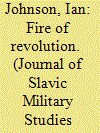

|
|
|
|
|
| Summary/Abstract |
In August, 1920, the fate of Europe hung in the balance. Bolshevik forces stood poised to take Warsaw, while Lenin contemplated the possibility of invading Germany. General von Seeckt in Germany considered renouncing the Treaty of Versailles, thus threatening a new world war. In France and Great Britain, senior leaders reluctantly and with great hesitation discussed military intervention in Eastern Europe. Using primary source material from American, British, German, and Polish archives, this study offers new conclusions about the landscape of post-war Europe through a counterfactual analysis of the Battle of Warsaw.
|
|
|
|
|
|
|
|
|
|
|
|
|
|
|
|
| 3 |
ID:
137555
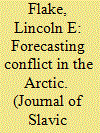

|
|
|
|
|
| Summary/Abstract |
The Arctic has reemerged as a region of geo-political consequence following rapid reduction in sea ice in the past decade. As the only non-NATO Arctic littoral state, Russia’s approaches to the many disputes in the region will undoubtedly have the greatest bearing on the future security environment. This article examines the two most threatening circumpolar disputes, sea bed delineation and navigation rights, and postulates that Russia’s policies on both issues conform to historical patterns. Recent Russian policy decisions are placed in historical context in order to gauge conflict potential in the Arctic related to these two disputes. The main finding is that the path-dependent trajectories of both issues are becoming ever more distinct as Russia articulates its Arctic policies. In particular, structural and historical factors encourage Moscow toward cooperation and compromise on sea bed negotiations but also suggest that Kremlin intransigence on navigation will continue, with potentially detrimental effect on regional stability.
|
|
|
|
|
|
|
|
|
|
|
|
|
|
|
|
| 4 |
ID:
137559


|
|
|
|
|
| Summary/Abstract |
Of the numerous events that comprised the Russo-German conflict of 1941–1945 but have since been almost forgotten, one of the most significant may have been the Soviet offensive that swept across the western Ukraine during the spring of 1944. Generally referred to as the second stage of the Soviet Dnieper-Carpathian Offensive Operation, in reality this offensive had a major, if usually unappreciated, influence upon the course of the Second World War. By closely examining the impact it had upon the German Wehrmacht, specifically in terms of German force dispositions and resource allocations, this article argues that the Soviet spring offensive in the western Ukraine played a major role in shaping the subsequent course of events in both Normandy and across the Eastern Front during the summer of 1944.
|
|
|
|
|
|
|
|
|
|
|
|
|
|
|
|
| 5 |
ID:
137553
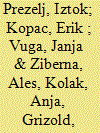

|
|
|
|
|
| Summary/Abstract |
The military transformation process typically focuses on the structural, operational, technical, personnel, training, and similar dimensions. Yet conceptual and practical approaches to such transformation have largely neglected the importance of the perceptional and subjective aspects that have frequently negatively affected this process. This article fills this gap by developing the Input-Process-Output Transformation Model and testing it on a sample of 55 military transformation experts from 23 NATO and PfP countries. The results highlight what are perceived to be the most important variables affecting the transformation input, process, and output that need to be incorporated in future integrated transformation strategies. It also turns out that transformation strategies need to increase the involvement of civil society, improve public support, the level of internal understanding of transformation goals, and the level of experimentation.
|
|
|
|
|
|
|
|
|
|
|
|
|
|
|
|
| 6 |
ID:
137554
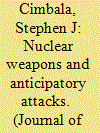

|
|
|
|
|
| Summary/Abstract |
Anticipatory attacks come in two forms. Preemptive attacks are first strikes based on the assumption that the opponent has already set an attack in motion or is about to, and the purpose of the preemption is to mitigate or neutralize the effect of the enemy’s move. Preventive wars, on the other hand, are undertaken to preclude a threatening power from increasing its capabilities relative to ours, assuming that smaller differences in power will lead the challenger to become more risk acceptant. With respect to nuclear weapons, deterrence is intended to preclude both preemptive and preventive attacks, although the former is judged to be more likely than the latter. Leaders authorizing a nuclear preemption would need to have high confidence about the intentions as well as the capabilities of the other state, and the requirements for fine-grained intelligence would be considerable, prior to any actual launch of delivery systems. Seeing into the other side’s world view, regardless of its apparent rationality or lack thereof, would also be prudent before undertaking a decision of such magnitude.
|
|
|
|
|
|
|
|
|
|
|
|
|
|
|
|
| 7 |
ID:
137558


|
|
|
|
|
| Summary/Abstract |
The T-34 was the most mass-produced tank of WWII. No wonder that it has become one of the most famous and well-known tanks of that period. Numerous authors have repeatedly described it as the finest combat vehicle of its time. But, as is usually the case, this tank had both values and weaknesses. Many of them were revealed in 1942–1943 when one of the T-34s was comprehensively tested by American military experts on Aberdeen Proving Ground in Aberdeen, MD. Some Soviet officers were present there as well. They collected and recorded the Americans’ statements and conclusions about the tank. In August 1943 an official report summarizing the Americans’ evaluation was sent to Moscow. Its contents startlingly differ from the common opinion about the T-34 and can surprise many readers. This article analyzes that report in detail, item by item, and explains the reasoning behind each. It also briefly outlines the history of T-34’s engineering and production and the roles of the people involved. As a result it makes it perfectly clear why this tank was the way it was, what were its real values and weaknesses, and why it had become so important for the Red Army during its struggle with the Wehrmacht in 1941–1945.
|
|
|
|
|
|
|
|
|
|
|
|
|
|
|
|
| 8 |
ID:
137556
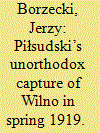

|
|
|
|
|
| Summary/Abstract |
ontrary to what some authors assert, the idea of ‘liberating’ Wilno from the Soviets did have the support of Polish political and military circles. What evoked reservations was merely Piłsudski’s execution of this idea. His Wilno operation was controversial from a military standpoint and its timing questionable, politically and militarily. It put Poland and its leader at significant risk. While ultimately Piłsudski was vindicated by a brilliant victory, it resulted in no small measure from good fortune.
|
|
|
|
|
|
|
|
|
|
|
|
|
|
|
|
| 9 |
ID:
137552


|
|
|
|
|
| Summary/Abstract |
This article argues that the current ways of conceptualizing and understanding Russian warfare are flawed. To improve this, this article reviews the current ways of approaching Russian warfare from post-independence to after Ukraine. Then, we investigate Russian warfare from the four spectrums of military, informational, economic, and energy, and from political influence operations. From this, we propose the concept of Full-Spectrum Conflict that captures the use of violent and non-violent means as well as the conduct of conflict in differing degrees of intensity from peace to war and the space in between. This remedies the problem of conceptualizing, and hopefully understanding, the conduct of Russian conflict.
|
|
|
|
|
|
|
|
|
|
|
|
|
|
|
|
|
|
|
|
|